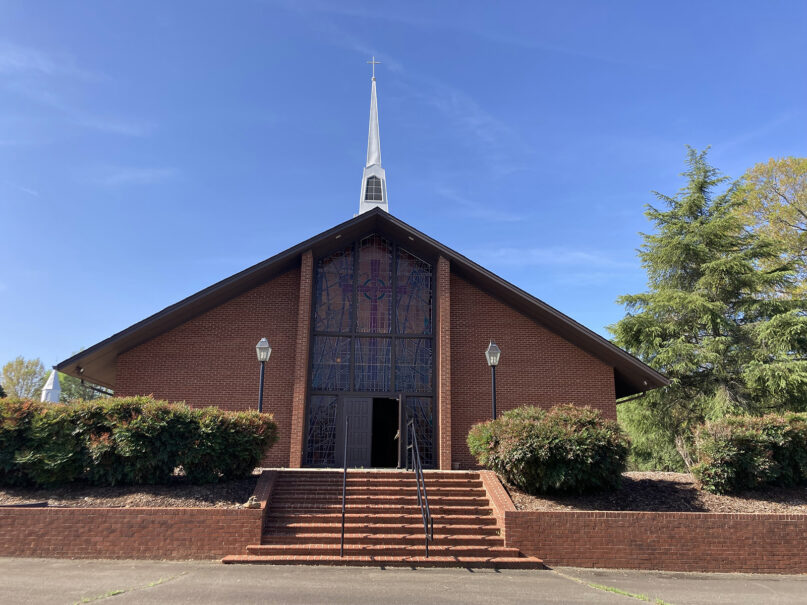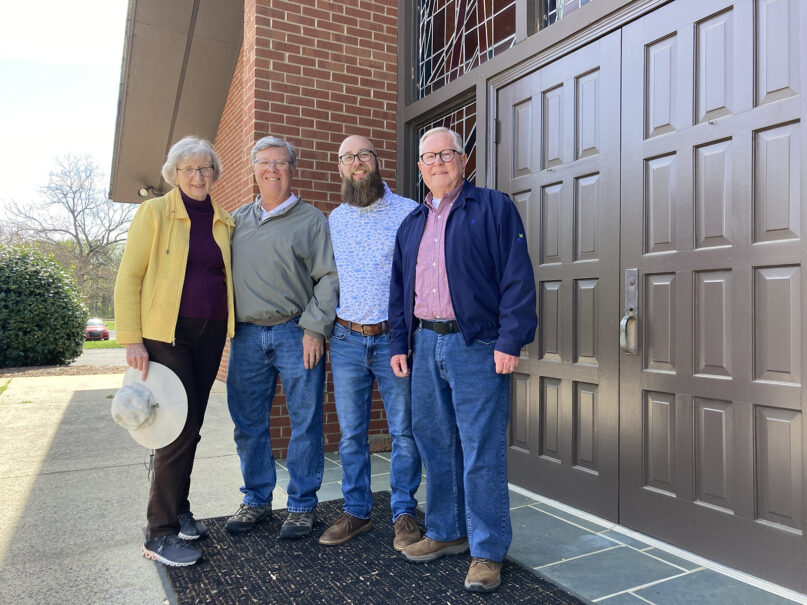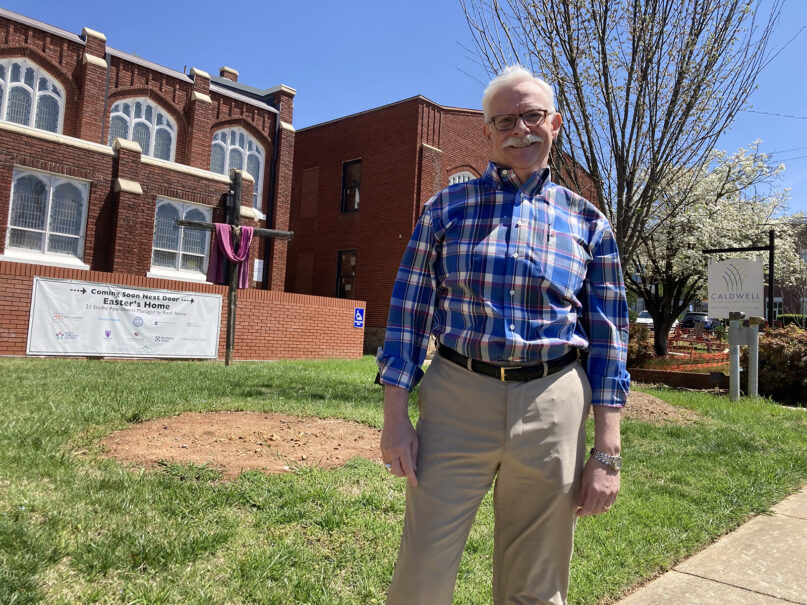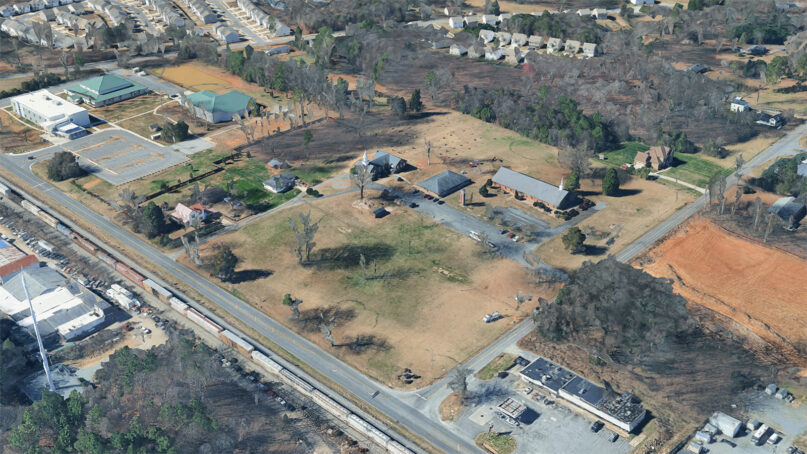CHARLOTTE, N.C. (RNS) — Four years ago, the Rev. Matt Conner presented his congregation with a stark reality: Newell Presbyterian Church had about 18 months of financial solvency ahead. The time had come to seriously consider its future.
Chartered in 1890 in what was then a sleepy part of northeast Charlotte dotted with dairy farms and tobacco fields, the church grew, and then started a slow decline. These days about 50 people attend Sunday morning services and the church has an annual budget of $190,000.
But Newell Presbyterian has one asset increasingly in demand in the now bustling neighborhood of subdivisions and apartment complexes: land. The church sits on 9.5 acres, accumulated plot by plot by devoted church members who had long since passed on.
After forming a “dream team” to consider its options, the church recently voted to sell a 4.5-acre parcel to a nonprofit developer for the construction of 50 affordable townhomes right next to its sanctuary. Homeowners would have to earn 80% of the area median income (about $85,000 for a family of four) to qualify. The sale is expected to be inked in October.
Newell Presbyterian is one of hundreds of declining congregations with underutilized space, excess land, deteriorating buildings and soaring maintenance costs. But these churches are finding that they can stanch their fiscal woes by selling or, in many cases, leasing some of their land and repurposing their properties for affordable housing.
At least 200 and as many as 400 houses of worship (mostly churches but also synagogues and mosques) have repurposed their property for affordable housing over the past decade, said Nadia Mian, a researcher at Rutgers University’s Edward J. Bloustein School of Planning and Public Policy who is cataloging those projects.

Newell Presbyterian found that in selling its land it had found a new treasure: its soul.
“I’ve gotten to watch and be a part of a kind of spiritual growth in this space and time and a calling to be even more mission oriented,” said Conner. “This is a church getting clearer about who we are and why we exist.”
Though the church hasn’t grown in numbers, Conner said it has grown in faith and commitment, and its members speak of a renewed sense of purpose and mission, a deeper spirituality rooted in a sacred responsibility to neighbor and place.
RELATED: Church membership may be declining, but many churchgoers are double-dosing
In 2021, on the Feast of Ascension, when Christians celebrate the resurrected Jesus’ leavetaking of his disciples, Conner asked a group of church elders to walk the grassy 4.5-acre field next to the church. “Pray, pay attention and dream,” he told them. “What do you see?”
They initially came back with different answers: a soccer field, a farmers market, a student hub for the nearby University of North Carolina Charlotte campus.
Over time, the church elders coalesced around a dream of a housing community that would nurture young families, just as the church had nurtured them 50 years before.

Trent Thompson, 71, remembered how he and his wife moved to Charlotte in the early 1980s so he could finish his undergraduate degree at the university after his service in the Coast Guard. Shortly after they found the church, their first son was born, 11 weeks premature. Church members enveloped the young family with care during the two months their son was in the hospital.
“The church loved us and helped us out with anything we needed, prayer requests, people visiting us, meals,” said Thompson. “That meant a lot to us.”
Freda Schlaman, 79, remembered that the church had a vibrant youth program that her two daughters loved — so much so, one of them later became a Presbyterian minister. “It was a small church and it was what we needed,” said Schlaman. “We fell in love with the people along the way.”
The church’s members envisioned an affordable housing complex that would allow today’s young families — many of whom are priced out of Charlotte’s competitive real estate market — to do the same. They were clear they did not want to build rental apartments, but rather offer working-class families — teachers, firefighters, social workers — homes they could afford.
That meant the church would build fewer units and likely get less money from the sale than if it had sold to a commercial developer. “A lot of churches will just say, ‘Sell it. Let’s get some money so we can have operating capital,’” said Thompson. “But our point was, we’re not gonna do that. As the stewards of the community, we wanted to help to rebuild the idea that Newell is a community that thrives on the family concept. We wanted people that get a chance to put down roots.”
The church turned to DreamKey Partners, a nonprofit real estate development company that has worked with a handful of other churches in the Charlotte area. Church leaders won’t say how much money they will get from the sale, since the contract hasn’t yet been signed. A lot also depends on whether the city will award the project the full $3.1 million from its Housing Trust Fund, designated to provide gap financing to developers to build affordable housing.
The church is already considering a phase two: renting out parts of its education building to nonprofit business incubators, perhaps starting a coffee shop, and creating a playground or park for the children.
The church’s goal, said Conner, using a biblical reference, is not to store up money in bigger barns. “We are selling some land for the sake of this call to build up the beloved community, and honestly all it costs us is a yes,” Conner said.
Eight miles away from the Newell church, another Presbyterian congregation has also committed itself to affordable housing. Caldwell Presbyterian has converted a 14,000-square-foot building that once housed Sunday school classrooms into 21 studio apartments for people coming out of chronic homelessness. After it opens in October, the church will turn the building over to a local nonprofit that will oversee day-to-day operations.
For Caldwell Presbyterian, the vision is the same as Newell’s, even if the initial impetus was not. A bigger, midsized church, Caldwell wasn’t financially squeezed. But like Newell, it saw a need.
“We’re in the middle of a profound and deep national housing crisis,” said the Rev. John Cleghorn, the pastor. “One of the ways the churches can make the most direct type of impact, is not only to provide the housing, but to provide a community adjacent to, in relationship with the housing. What could be more Christlike?”

Like many cities, Charlotte welcomes the churches’ building boom. The city’s Faith in Housing initiative gives faith-based organizations tools and resources to carry out affordable housing projects. A summit the city held last year brought together leaders from some 90 houses of worship for a daylong educational workshop about the hows of affordable housing and the variety of city, state and federal tax credits, grants and loans.
“When you think about it, honestly, who has the most land? Religious institutions and schools,” said City Council member LaWana Mayfield. “What we’re doing is creating a tool kit to help educate and energize the community to not just think about housing, but to reimagine their space.”
Charlotte’s Mayfield Memorial Missionary Baptist Church, a predominantly Black congregation that built 51 rental units for people making 30% to 80% of area median income, is a big believer in congregations working on affordable housing.
“If we could get just 5% of the churches in Charlotte to do this — and not just churches but faith communities — our housing problem looks very different,” said the Rev. Peter Wherry, the church’s pastor.
One thing Newell’s newfound mission won’t do is save the church’s finances long term. Members have no expectation that the owners of the townhomes they are building will want to join the church. And it is possible the church may dwindle in size even more.
But they are also clear-eyed about the larger vision of community that is driving them.
“You know, this is not our land,” said Thompson. “God created this land for us to use. This is not just for the church but for others who need it.”

RELATED: How a former schoolteacher became the next Lutheran presiding bishop
Original Source: